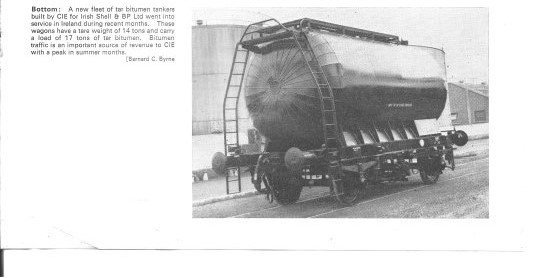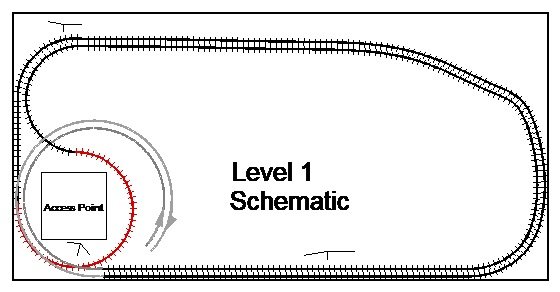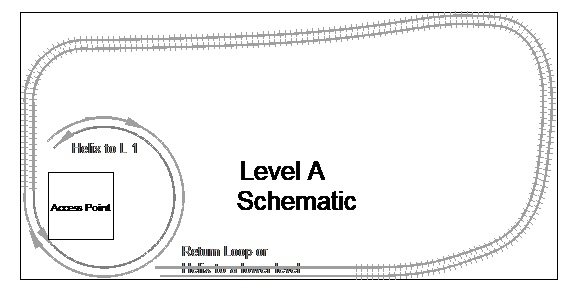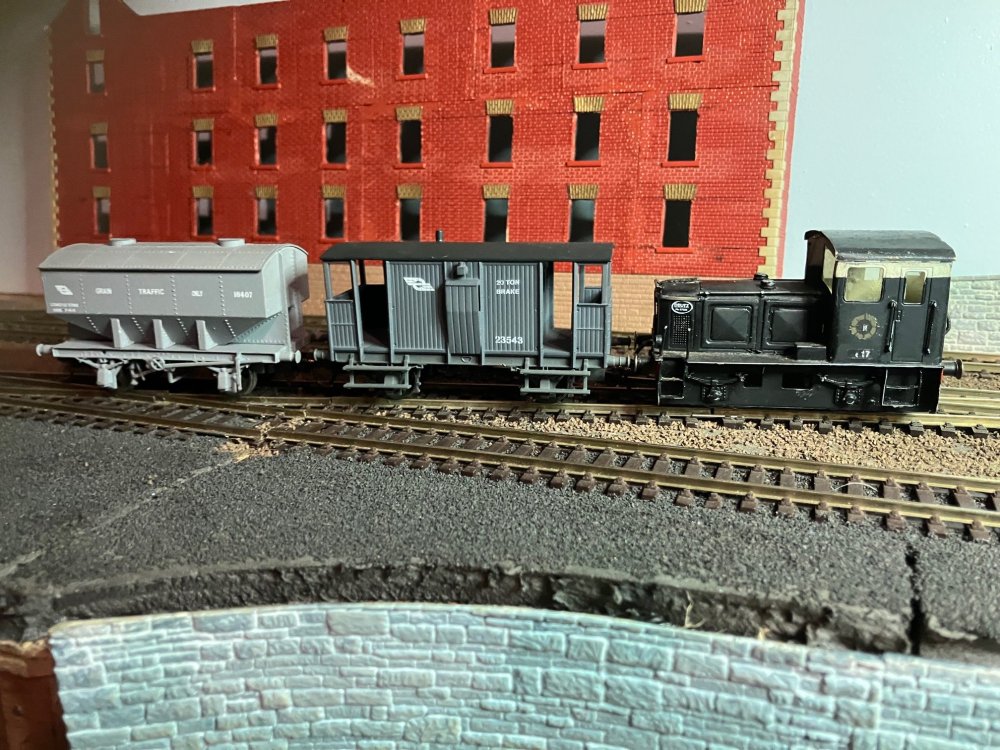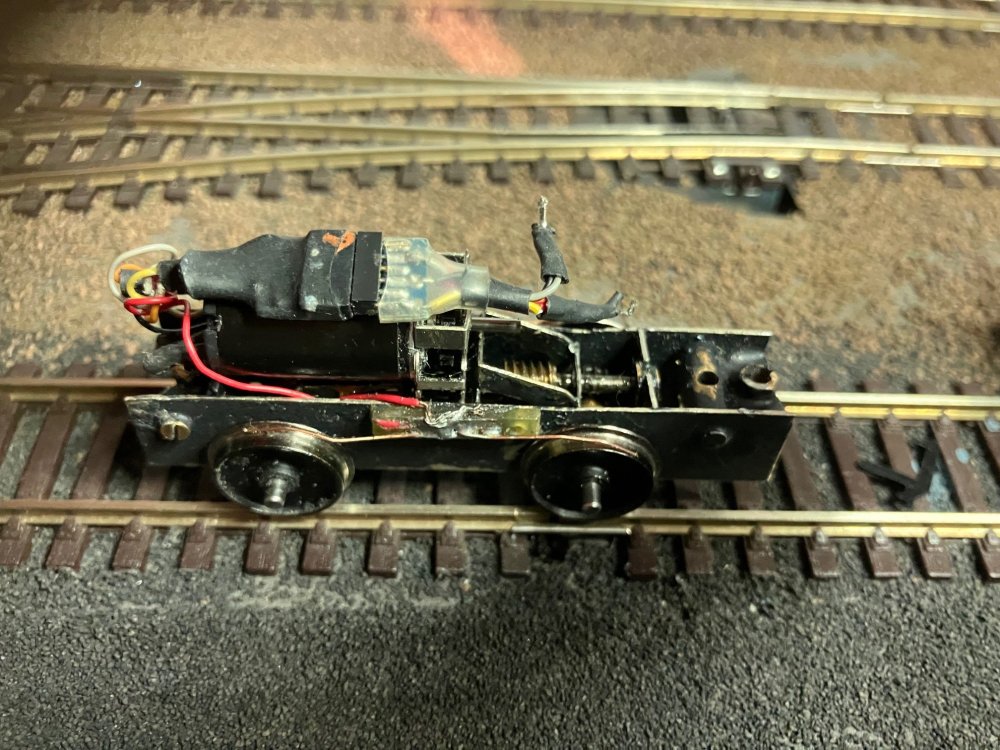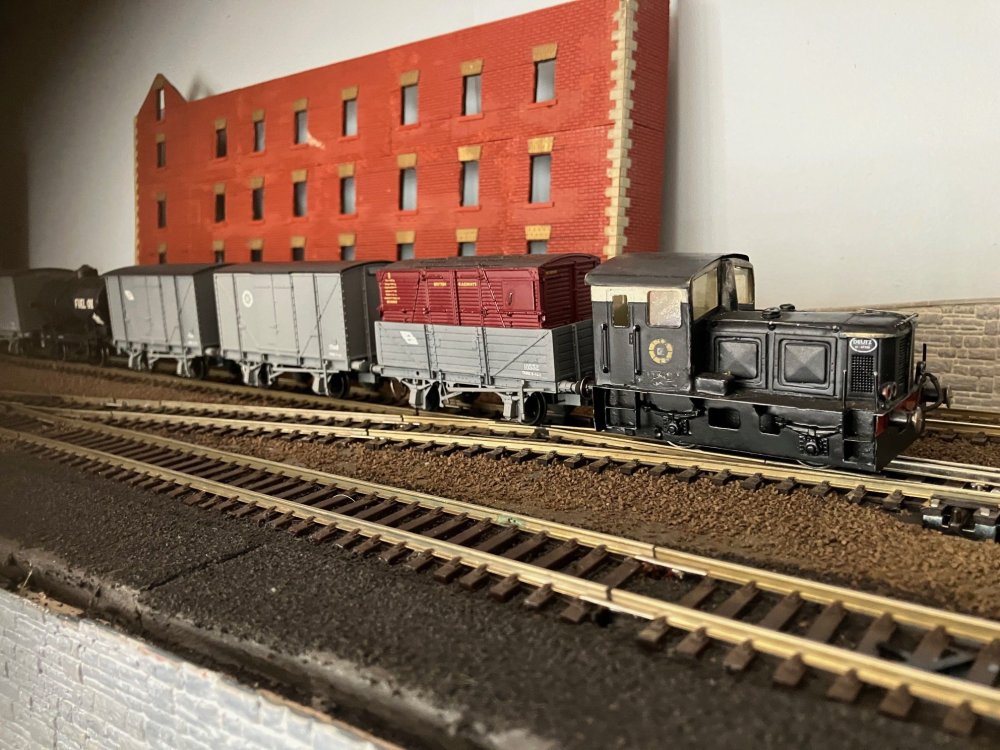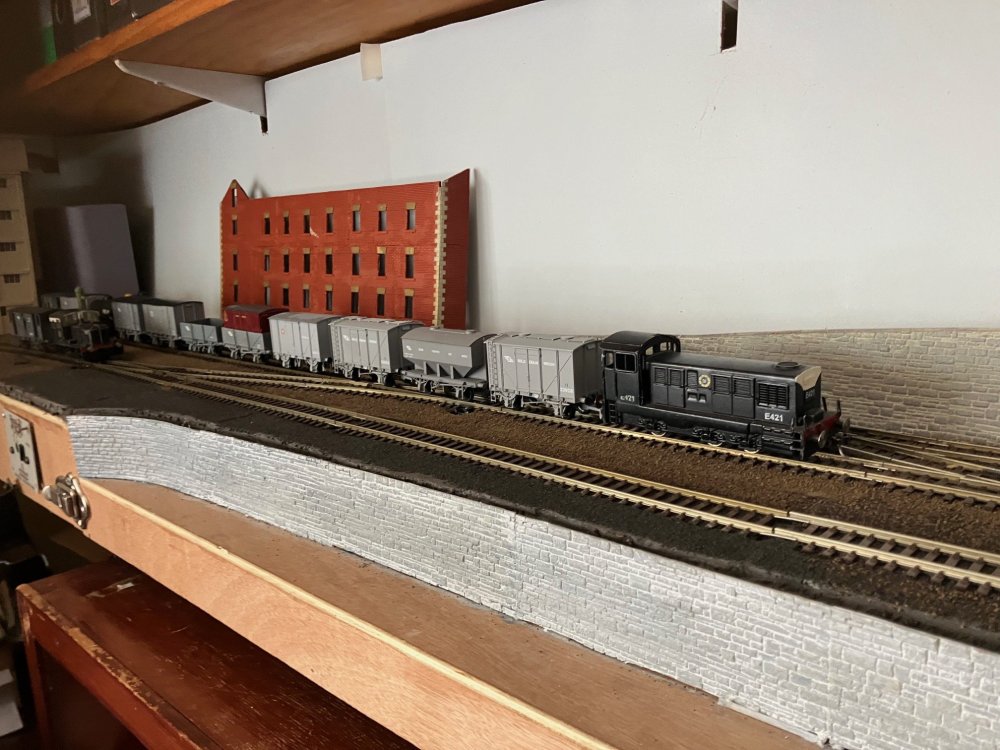-
Posts
4,879 -
Joined
-
Last visited
-
Days Won
119
Content Type
Profiles
Forums
Events
Gallery
Everything posted by Mayner
-
20 wagons was the maximum load for a fully fitted train of Bubble Wagons hauled by a single 001 or pair of small GMs (121,141,181) 20 wagons would have been the normal load on bulk cement trains to destinations like Cabra, Cork, Athenry, Waterford, Limerick-Athy trains may have been shorter & possibly Tullamore. Bulk Cement to Belfast and Derry transported in the consist of cross border Liner Trains. In loose coupled days single or short cuts of Bubbles were conveyed in mixed goods trains complete with Brake Vans, several Jonathan Allen photos published or Bubbles on Cross Border Goods Trains, and I remember in the mid1970s seeing pairs of Bubbles on a number of occasions in the middle of the consist of the Claremorris-Limerick goods train (most likely returning empty from Ballina (Asahi construction project)
-
Interesting the two Bitumen Tanks on the Sligo Liner passing Maynooth in the Video in Fishplate 7s Posted January 20, 2021 appear to be numbered in the 500 series although they appear to have domed tank ends and at least one of the Bitumen Tanks on the Sligo Liner in Valk's initial post appears to have domed ends indicating that its possible that some the Shell BP Bitumen Tank Wagons survived at least until Bitumen traffic ceased. The Burmah, CIE Fuel Oil tank wagons introduced during the 1970s ran on the "Standard" CIE 20' Skeletal Underframe complete with ISO spigots appear to have been considered new builds presumably in addition to the 300 27101 series flats, while the 26730-26740 series Tank Cars introduced 1978 apear to have been classed as conversions of the 27101 Flats which had largely become surplus to requirements with the introduction of the 22'6" Flats and large nos of Bogie Flats.
-
I am unable to proceed forward at this stage with the updated artwork for the Flat Wagons as a result of health issues & family commitments. My body sent me a warning that I was overdoing it shortly after my last post.
-
The wagon in the Lixnaw photos was basically the Inchacore version of the 1952 & 62 Charles Roberts featured in MOL_PMB recent post. The Inchacore built wagons appear to have been built on a 'Standard Irish' steel underframe as opposed to a British RCH tank wagon underframe. I used the tanks from the IRM Weedkiller Train set with my own 3D printed wagon Chassis, but decided it was not worth the hassle of trying to fit the lagging to the tanks. I guess Bitumen tanks based on the recent IRM Fuel Tank wagons would pass the 2' test or possibly the Bachmann anchor mounted tanks
-
The 'Jumbo Tank' wagons with domed ends built for Irish Shell BP tar traffic in 1972 appear to be something of a mystery with no running numbers or number of wagons built in the magazine article and apart from 26729 an otherwise watertight wagon number series of tank wagons between 26723-26728 (Burmah 5000Gal 1972 ) & 26730-26740 (4500Gal 1978) The fact that bitumen tanks of the same design exist at Ballyculane & Ferns and the magazine article writing about a fleet of wagons indicates that CIE built more than one Jumbo Tank with domed ends. Interestingly both Ferns & Wellington Bridge (serving Ballyculane) had closed to railborne tar traffic during the mid 1970s its just about possible that the Bitumen tank wagons may have occupied the 26729-26740 number series. The 'modern' CIE Bitumen tank wagons were similar in general outline to the 4w 35GWT tank wagons introduced on BR during the 60s though shorter, 'back in the day' about 1980! I shortened a Peco N Gauge 35GWT tank to resemble a Burmah tank wagon & one of the UK finescale mags featured an article om converting the Hornby 35GWT Tank Wagon into a bitumen tanker mainly by re-painting and weathering. The 'Jumbo Tank Wagons' in the video appear to be the ESSO variety with domed tank ends. There is an interesting series of 1976 photos in Rails Through North Kerry JHB & Barry Carse 2016 of 023 shunting/working 23855 (1950s Inchacore built Bitumen Tank wagon between Lixnaw Station and the Co Council depot.
-

trackplan [Answered] Can a 'double deck' layout be achieved?
Mayner replied to Josef2000's question in Questions & Answers
I visited several multilevel layouts including those with spirals, a common thread is that the occupy large floor areas, double garages, purpose made layout rooms or basements, as the helixes, reverse loops or dumbells required to make these layouts workable take up a lot of space. The majority of multi-layouts visited tended to be in the traditional category popular for modelling American mountain railroads with two or more levels of track running through the same scene, the different levels linked by helix on an incline often in a folded 8 configuration with a single track main line with several yards and crossing places in a mountainous scenery complete with high steel trestles and tunnels. The Double Deck category appear to be mainly based on railroads/railways in a plains/prairie as opposed to a mountainous setting on a shelf style baseboard with a backscene, Bill Darnaby in the United States appears to have been one of the pioneers of the Double Deck concept with his Nickle Plate layout and built a mock up a two level mock up section in his basement to check deck clearances including a typical wayside Depot complete with grain elevator featured in one of the Model Railroader Railroad Planning annuals. MRH Mag forum provides practical advice in considering a Double Deck Layout https://forum.mrhmag.com/post/what-to-consider-with-double-deck-layouts-12212304 I have marked up to layers of Josef 2000 plan to provide an insight into the space required to fit a helix and a reverse loop. providing sufficient vertical clearance for the reverse loop to cross over the heilix could involve some challenging carpentry. Another point to consider is that you will need to take curvature into account in working out the maximum load of a loco hauling a train up a spiral/helix. On the prototype the grade is often reduced on curves (compensated) to reduce the effect of friction hauling cars around a curve. https://en.wikipedia.org/wiki/Ruling_gradient Level 1 Schematic showing reverse curve or half a dumbell at one end to allow trains to run continuously and spiral to allow trains to run to a lower level, Showing helix descending to lower level, the track on the bottom right could descend to a lower level or formed into a return loop outside the area of the helix. The terminal roads on this plan would need to be reversed/mirrored to allow a train from another level to terminate in the station, another alternative would be to reverse the direction of the lower section of the helix to run towards the bottom right of the layout -
Oops posted to the wrong thread
-
I built a number of American style 'operating' layouts mainly, though the current iteration is large scale (1:20.3) in the garden over the past 45 (gulp!) years, usually dismantled as a result of a move to a different house or country. For me the main focus has been main/secondary main line operation between a Terminal and a fiddle/staging yard during solo operation with little or nothing happening at intermediate stations or sidings, 1st layout was Irish end to end in N Gauge in 1980 based on contemporary CIE secondary main line operation with Terminus Station, small Junction Station with crossing loop, open as halt and for seasonal beet traffic and junction to a goods only branch serving a port importing oil. Main line passenger services were 3 daily passengers services to Heuston, a Night Mail, Loose-coupled Goods or Liner and Beet & Oil trains as required. At the time I had grown frustrated trying to fit a OO gauge layout into the available space and N scale provided a more attractive alternative in terms of realistic scenery and train length, contemporary N gauge mechanisms were better quality than what was available in OO and at the time Irish rtr was a pipe dream some element of scratchbuilding/modification was required for Irish modelling regardless of scale. 2nd & 3rd layouts were N Scale American in the 17'6x8 ' attic of my house in Dublin and in a 24X12 garage of our house following our move to New Zealand. The initial Attic layout was a large oval set up on a shelf set up a purlin level with a crossing loop on one side and a staging on the opposite to get something running quickly and test feasible train length before building a 'permanent' layout. I found that 50 American (40-50') freight cars were the practical limit for the Micro-train couplers, but settled on a max 20 Car length (3-5 Diesel units) for the staging and main year. My main focus was on running through freights between the Main Yard (a Junction & Division Point) and the through Staging Yard. The operating sequence was based on the Delaware and Hudson in Binghampton NY the junction point between the routes from Canada & New England to the South & East and the route to Buffalo-Chicago and the west. The 2nd layout featured a folded 8 track layout to maximise the length or run and I located the staging tracks behind the main yard a form of 'surround staging' as described in the States, the main advantage of the extended length of run was that it increased the illusion of distance, a train taking 5-10 minutes to reach its destination after leaving the yard or staging (several hours in real life), allowed the operator to plan or set up for the next move. There is a saying that switching/shunting takes the same or similar time to carry out on a model as the prototype. In practice switching and running the through freights kept me and visiting operators so fully occupied, that we did not have time to switch the local industry tracks (Grain Elevator & Mill) or use the crossing track or switch the industries on the scenic section. Which begs the question whether they worth the time and effort modelling in the 1st place. 3rd layout in a 24X12 garage did not get beyond the set up stage because of a house move with the yard and staging set up on one long side and temporary track on the peninsula. Most valuable lessons learned was to set the staging at a slightly lower level than the Main Yard to improve the visual separation and placing one end of the staging close to the main yard, this would have allowed a more realistic length of run between the Main Yard and an intermediate crossing place intended to be a junction with a branch line serving a mine and the reverse loop. The current iteration of the 'American' layout this time on the Colorado narrow gauge a large loop in the garden with a branch/main line to or from a staging in the garage. My main motivation is still running trains between the Main Yard and Staging, operation is more laid back with one or two way freights during an operation session that can keep a visiting Operating Crew busy for an hour or so as switching a Car or two can take as long as on the prototype. Though recruiting and retaining a crew can be an issue these days
-
Very Impressive
-
I am not really familiar with the Irish railway drawings published in books and magazines during the lqast 20 or so years. An other issue is that out of print books with Irish drawings may not be available in the public library system New Irish Lines archive may be a good starting place https://newirishlines.org/archive/ It includes J P James 1992 archive of drawings published in magazines & on line copies of IRN (usually contain drawings) from 1992-2023 which should keep you busy. Diesel Dawn (Colm Flannigan) Colourpoint 2003 covers the development of the diesel railcar in Ulster from the 1930s-late 1960s and contains small scale drawings of many of railcars that operated in the province during this era.
-

Old Goods Wagons with Center Roof Canvas?
Mayner replied to Auto-Train Original's topic in Irish Models
The 'soft topped" or convertible wagons were gradually phased out on CIE during the 1950s most likely gone by 1960. Although the majority of Convertible Wagons were built in the 19th Century and were 14' long, the MGWR had some (approx 100)longer 17'6 Irish Railway Clearing House (IRCH) 'Standard Covered Wagons" of the Post WW1 era built as convertible wagons. The MGWR IRCH 'convertibles" had the same rood profile as a standard H Van but fitted with a removable canvas centre. CIE replaced its remaining soft topped wagons and GSR & pre-amalgamation 14' calltle Wagons (K) with longer KN wagons during the 1950s, but ended up with a surpluse of KNs as the traffic declined during the 1960s -
During the 1950s Great Northern preferred option was to dieselise with German Diesel hydraulics with a 1000hp B-B for main line passenger and goods traffic, so a potential might have been had the Dublin and Stormont governments accepted the proposal
-
Academically your Tutor Examiners are likely to be more interested in your research methods and how you arrived at your conclusions than the accuracy of the data present or project findings. If you use AI or Wikipedia clearly state it & any reference to the source of the original data. e.g. Sean Cain as the source of the data from your use of Microsoft Trust Pilot Your school/examiners cannot reasonably expect you to research material thats not readily available from your school, local public library or an accessible on-line source, or reasonably expect you to buy the BNM books referred to by Paul. You can only be expected to use research resources you can readily access. If you are working to a deadline to submit the project, you need to draw a lne that you have completed your research and submit the project. As someone who once made a (good) living by researching & writing reports to tight deadlines, I quickly relaised that it was necessary to draw and line and only consider the most relevant information in order to complete my reports on time. If its any consulation my wife ran into a lot of hassle from her Academic Supervisor in 2007 over my wifes use of AI and an unusual presentation style in her final Doctorate Thesis, effectively refusing to sign off on my wifes work. The head of the Faculty advised my wife to submit the thesis if she (my wife) felt confident about the thesis. Interestingly my wifes Acedemic Supervisor who previously disowned my wifes thesis, jumped on the bandwagon to take the credit for my wife's success when my wife was awarded a distinction because of her use of AI and the graphic presentation style of her project. So my advice is if you believe in your have completed your research to the best of your ability, submit your project and ignore the background noise. My secondary school project when I was 14-15 was a proposal for a Heuston-Clondalkin suburban train service using a Railway World article on CIE as my sole source. The only criticism was that the external examiner did not consider a surban rail service an original subject for a project (at the time CIE had plans for an Underground system for Dublin which was never built!)
-

Bantry (on the correct side of the Irish Sea)
Mayner replied to meathdane's topic in Irish Model Layouts
The Gulf Oil Whiddy Terminal was basically a tranship point for crude oil arriving by Supertanker from the Middle East and smaller tankers distributing the oil to British and European refineries. Even if the West Cork remained open (& a pipeline existed between the Youghal Branch & the Whitegate Refinery its likely that the refinery would have continued to receive crude oil by sea being more convenient and cost effective than rail. Had Bantry remained open its likely that the Whiddy Terminal would have lead to an increase in general goods traffic in a similar manner to Tynagh mine boosting Loughrea branch traffic although it did not transport the output, with ships supplies (food, consumables & spare/replacement parts) arriving by rail in H Vans. Grain wagons were just as likely to transport animal feed as malting barley and could be transhipped to a lorry for delivery to a customer. There is a photo in the National Library O'Dea collection of a grain wagon being unloaded at Fermoy using a small portable conveyor to transfer the load to a lorry, no need for a pit or a silo! Bantry Station was the towns second station, the original was on the hillside on the Cork side of the town near the current Hospital former Workhouse and seems to have been abandoned after the extension was opened, possible site for goods station or stone built 19th Century flour/feed mills or even a distillery, Middleton and Bandon had major distilleries why not Bantry? Alman's (Bandon) seemingly dependent on the US market closed because of Prohibition wiped out its major market, a lesson for us all today? What if Bantry survived into the Railplan 80 era most likely traffics would have been trainload fertiliser running for a locoa Co Op as required, Bagged Cement weekly tran possibly serving Bandon, Dunmanway? and Bantry (railhead for Skibereen) Another potential would have been a weekly Bell Liner conveying frozen fish from Castletown Bere (or possibly move the fleet to Bantry), at one stage CIE operated a weekly Bell Liner from Sligo conveying fish traffic from Killybegs (possibly 20' Refrigerated containers) On a practical note I'd recommend laying permanant track on cord or a dense foam underlay (I use camping ground sheets), the resilience of the foam allows for more reliable running and a lot quiter than laying track directly on the baseboard. -
Alan, worked out quite straightforward in the end, the Hi Level gearboxes were self jigging when assembled, only significant modification was to cut away the surplus metal in the now redundant motor mount and to get my head around the idea of using the rotating layshaft as a pivot for the rocking axle/gearbox. The system is the same in principal to the motor, layshaft and gearbox arrangement used in a lot of RTR N and narrow gauge locos. I will probably use the same arrangement if I ever get around to assembling the 21mm gauge chassis supplied with the original Worsley Works G Class and a D401 if I ever get around to it. Reducing the thickness of the axle bushes and careful adjustments of the B-B transformed the running of the loco, better hide that OOF B-B gauge when using Bachmann or other RTR wheels. Interestingly I had a similar problem years and years ago after I picked up a job lot of PC models coach wheels (cutting edge 4mm kit manufacture) wheels were very nice with a narrow thread but a narrow wheel profile, had to vary the B-B for the wheelsets to run reliably.
-
The Ferries with their 3 1/2 hour crossing are effectively the backbone of New Zealand's SH1 road and Trunk rail system linking . The 6th Labour Government which included Winston Peters (a very canny politician & pro-rail) party NZ First as a coalition partner approved the replacement of the existing ferries with new larger ferries in 2021. Like CIEs late 1940s order for twin engined Sulzer 'express locos' Kiwirail was forced to cancel the order for the new ships following a change of Government in late 2021. The new 6th National Government a coalition of center right National, NZ First and libretarian ACT struggled to decide on whether to replace the ferries with road only or combined road and rail until Winston insisted that the ferries had to be rail capable or possibly withdraw his support for the Government. National is best described as agnostic when it comes to spending public money on rail, ACT would consider it a waste of public money. Interestingly the Labour leader later claimed that Winston had signed off on the original project while in coalition with Labour in 2019. https://www.stuff.co.nz/nz-news/360635225/cook-strait-ferries-saga-explained Original project costs had blown out over port works at Picton and Wellington where the existing ferry terminal requires replacement due to high risk in the event of a severe earthquake built on port & city formed as a result of an earthquake. Interestingly the rail decks on the new ferries are to be designed to accommodate 40-60' wagons or 120TEU same capacity as the cancelled order so same rail capacity as the cancelled 2021 order. Although the project is likely to over run and Government likely to end up as a price taker, the new ferries potentially secure the future of the 336km line south from Picton to Christchurch which was severely damaged but reinstated following the 2016 Kaikoura earthquake While there is talk about saving the taxpayer billions, Kiwirail have had to pay a cancellation fee to Mitsui the Korean shipyard that apparently had started work on the two new ferries, the Government have not disclosed the projected project cost for the replacement ferries and port works, claiming it to be commercially sensitive, though more likely Ferry Holdings a Company established earlier this year to procure the ships and manage the project has is only at the project scoping and preliminary costing stage. The whole saga is not unlike the Mary Harney's as Transport Minister in the newly elected FF government during the mid 1990s cancelling CIEs original Dublin Light Rail project despite EU funding approval apparently in response to concerns that the Light Rail System would add to city center traffic congestion and would be ineffective from a public transport perspective based on a projection that only 1% of Dublin area commuters would use the Light Rail System. More likely explanation was that it was seen as a FG Labour coalition project and the incoming Government did not want CIE with its history of poor industrial relations controlling the Dublin Light Rail system. The EU Dublin Light Rail funding was diverted to upgrading Maynooth suburban services, including the reinstatement of double track between Clonsilla and Maynooth, a new signalling system and station improvements. CIE still being in the dog house Light Rail Project staff were transferred to the Rail Procurement Agency although still working from Portacom in the Heuston Carpark, the Dublin Light Rail Project was re-christened LUAS and the operating contract was awarded to Connex and a non-strike agreement agreed with the Unions representing LUAS staff. In the end the LUAS project was 100% funded by the Irish Government although 10 years earlier the project was promoted as an EU funded project a benefit of Ireland joining the Single Market and closer European integration. I guess the craftiest politicians are those that focus on keeping in the news and getting elected.
-
- 3
-

-
Nicknamed 'Sparrows' (Spanish Arrows) in a similar manner to the original 2600s Arrow railcars or Jarrows. (Japanese Arrows) Remember a friend commenting that a Northern Suburban driver calling the 2700s 'Spanish crap' when asked what he thought of the new railcars. First saw the 2800 in service on the Northern Suburban when I returned to Ireland for a couple of weeks in 2005, what impressed me was the sheer intensity and frequency of service with the new railcars compared to a couple of years earlier when most services were worked by MK3 Push Pulls. Travelled on Northern services on three different types of train during the past 30 odd years, 1st refurbished Park Royal hauled by 141 around 1989, 121 hauled Push Pull late 90s, 2800 in 2005.
-
Managed to make some time for modelling on Saturday and Sunday evenings after an unpredictable and challenging week. This time adjusting the B-B and pick ups on G617 to try and achieve more reliable running. The loco which is on a scratchbuilt compensated chassis had a tendency to de-rail the fixed axle while running through Peco small radius points. I still have the original Worsley Works 21mm gauge chassis and was seriously considering converting it to a OO rigid chassis as a replacement for the compensated chassis. I replaced the existing North Yard (NZ supplier) wheel sets I originally used on the G with a set of spare wheels I had from a Murphy Models/Bachmann B141 (original release) for improved pick up, but struggled to achieve a 14.5mm B-B on the rigid axle due to the thickness of the insulation bush on the Bachmann wheels. In the end I reduced the thickness of the brush using a flat needle file, thus correcting the B-B and adding some much needed play between the axle bearing and wheels significantly reducing friction, the loco runs freer and motor a lot cooler following this modification. G617 which was assembled about 20 years was originally fitted with a Black Beetle motor bogie, which I may have re-used in a Wickham car and I built a replacement OO Chassis for use on NorthWharf about 2-3 years ago. Replacement chassis uses a step down gearbox which in turn drives a layshaft with final wormdrives to the axle similar in principal to the Bull Aunt and drive systems used in N and Narrow Gauge HO locos. Motor and drive components supplied by Hi Hevel although the step down drive 'Tender Riser' is intended for 4mm locos with the motor in the tender. At the time I was tempted to use a High Level 'Quad Driver' similar to that produced for Industrials like a Ruston 0-4-0 but wheel base was too short for a G Class. Chassis is compensated by allowing one axle/gearbox free to rock pivoted on the layshaft and now appears to operate quite reliably. The wiring harness above the motor is a DCC Concepts 6pin DCC socket with a DC jumper rigged up from a DCC plug. I have a stash of 6 Pin DCC decoders somewhere, I bought a a selection of 1 & 2amp 6pin decoders from a selection of manufacturers but need to find them! G617s decals are looking the worse for wear but the Duetz 'plates' still look reasonable, I need to ask Des for some replacement running numbers and CIE logos. E421 assembled from a Shapeways shell with my own detail overlays is running once again but needs ballasting, glazing and some paint touch ups. My own 3D printed and IRM bulk grain wagons.
- 392 replies
-
- 13
-

-

-
Its was a bitumen tank car, probably not of Irish or British origin. Possibly imported by an Irish bitumen imported/distributor. The coupler pocked on the end of the chassis looks the wagon had some form of Centre buffer coupler draw gear similar in principal to that used in the States and elsewhere. Possibly from some Eastern European narrow gauge system that operated into the 90s The tank is a lot shorter and the tank ends (cladding) quite different in appearance to the small number of Bitumen Tank wagons imported by ESSO in the late 60s. The Bitumen Tank wagons were basically to the same general design as the Heljan model, but with insulated tanks clad in aluminium, https://paulbartlett.zenfolio.com/essobitumenrebuilt C
-
I remember the Guard of the Sunday afternoon Longford-Connolly passenger telling me in the Spring of 96 that CIE had placed an order with Alstom for 27 Railcars for a similar price to 19 Mitsui railcars. Their delivery and introduction into service was quite protracted to say the least requiring a lathe number of modifications before they were allowed to enter service. IE introduced a through Sunday afternoon Ballina-Waterford service probably aimed a Athlone & Waterford RTC students that actually appeared in the timetable intended to be worked by 2700s that had not yet entered service. They eventually displaced 201s and MK3 Push Pull sets from Pearse-Drogheda services for about 2-3 years in the early 2000s before being replaced by 2800 Class Units and transferred to Limerick where their reliability improved careful maintenance & less intense usage than Dublin. By contrast the AEC railcars introduced by CIE in the early 50 operated for approx. 20 years in Main Line and Suburban duties before being converted into non-powered units after British Leyland ceased to supply engine and transmission parts for AEC railcars, The 2700s may have a shorter in service life as a result of their slow introduction to service and being out of service for many years. Be interesting to find out whether IE seriously considered the economics of upgrading the Alstom Units (2700 and DART) to improve reliability/reduce maintenance costs or was its simply cheaper to replace the Units with new possibly dual mode stock. That young Guard appeared to enjoy his work and optimistic about the futher of the railways all those years ago, you begin to feel old when you remember 3 generations of Irish passenger trains entering and being withdrawn from service (Supertrain, MK3, Alstom diesel railcars).
-
Back in the day would you believe 2013-14 Nelson Jackson as a teenager built some convincing models of NCC and possibly BCDR stock complete with their distinctive outside W Irons using a mixture of kit bashing and scratchbuilding techniques. Outside W irons seem to have been fabricated out of plasticard. Also built a NIR 70Class railcar set & British outline stock, all to a consistentlly high standard of modelling
-
David's comments about the railways Common Carrier obligations were the railways & possibly CIE & UTA road services were obliged to accept and transport all goods at a fixed Published rate is an interesting one. Internationally the ending of the railways 'Common Carrier' obligations (CIE 1958?) and the later de-regulation/liberalisation of road transport were significant turning points in the large scale shift from rail to road transportation and the shift of rail from a retail customer faced operation to a wholesale business that transport very large Volumes/Tonnages of freight for a small number of large customers. The railways lobbied to be relieved of their common carrier obligations which like David's example of the lady that manufactured 'posh hats" obliged a common carrier to accept all traffic offered at the published rate even if it was loss making, the flip side of the coin was that the railways were prohibited from offering discounted or reduced rates to high volume customers. Although CIE largely retained its steam era railway with a large number of small stations following the ending of its common carrier status CIE largely focused on attracting and retaining high volume customers by offering discounted rates for large customers such as Irish Cement, NET, Guinness and shipping companies like Bell who used CIE as its Irish distribution system. The shift to Block train operation ended the days of wagon load where a farmer or a merchant would buy a wagon load of fertiliser or cement to unload at the local station at his own leisure, largely ending that connection between the customer and local staff. There was the story of the local station Agent in New Zealand phoning customers to let them know their goods had arrived at the station, then later delivering and collecting sundries traffic from local homes and businesses for shipping for overnight delivery the next day. Phone and telex but all admin was paper based. Irish Rail probably managed to hold on to its relatively extensive railfreight network for so long because of CIEs almost monopoly position with surface transport and very strict licensing of road transport. Because of the difficulty in registering a Licensed Haulage business, many Irish companies and Multinationals operating in Ireland owned their own transport fleets and were internationally renowned for their efficiency. The final nail in the coffin of Irish Railfreight was the de-regulation/opening up of the Irish Road haulage industry making it attractive for multi-national and Irish owned transport and logistics businesses such as TNT, Irish Express Cargo to enter the industry quickly wiping out Irish Rails Sundries and Individual Container services. the remaining large shippers such as Guinness and Cement Limited shifted to road apparently as a result of a significant increase in freight rates when their existing (long term?) contracts came due for renewal in the mid 2000s.
-
Love the station and railway cottages a seldom modelled feature but common in real life
-
I managed the construction of a large Warehousing and Distribution Centre in North Dublin about 25 years ago. At the time the warehouse was the largest in Ireland over 12,000Sq Ft & we ended up constructing a 4,000Sq Ft ware house on the second phase to store the output of one of the American PC (personal computer) manufacturing plants, total project was over I£12m in value built over 18 months The warehousing side stored the output of various Irish manufacturing plants high value goods (mainly electronic & IT), before being distributed (exported) to various destination in the UK and Europe approx. 30-40' containers arriving and departing every night. One of the more interesting aspects was the level of security with Satellite tracking of trucks (usually accompanied trailers) from the Distribution Centre to their destination in the Uk or Europe. In the control office I was once allowed to track a truck in real time delivering freight to a destination in the Netherlands. Historically rails had a poor reputation around security and timeliness/reliability of delivery, fine for heavy bulky freight such as coal, mineral traffic or train loads of grain, milk powder or other products from New Zealand's dairy plants, but not really suitable for the high value exports from Irelands Pharma or IT manufacturing plants. With Brexit its more convenient to send Ireland's high value exports by direct RoRo ferry from Dublin or Rosslare to Cherbourg or Le Harve avoiding the problem of 'landbridging' across the UK. The less valuable exports by container ship from Dublin, Waterford or Cork to ports such as Rotterdam Locally the dairy industry is set up to use rail with a small number of very large processing plants controlled by one dominant processor, in some cases bulk milk is transported (by the trainload 12 Bogies 1000T train ) from a small number of collection points in intensive dairying areas to a centralised processing plant or in the case of the Waikato dairy products are transported by feeder services (typically 8-10 bogie flats 16-20 TEU wagons) from a number of medium sized processing plants to a large warehousing complex for consolidation and storage before eventual transport again by the train load 30-50 Bogies--60-100TEU trains. Irish dairy industry has been set up for many years to export its output by road using Ro Ro ferry to the UK and the Continent. Avonmore's daliance with rail during the 90s was based on importing cattle feed (Mollasses & Grain) through Foynes, Waterford and later Dublin ports with minimal capital investment by Irish Rail attempting to transport freight at marginal cost using low capacity fully or almost fully depreciated rolling stock.
-
I remember reading somewhere that Coca Cola use rail rather than road for its Ballina Beverages operations in order to claim Carbon Credits which can be used to offset some of the Emission Costs on its global operations. It appears that there was little difference in cost of shipping by road or rail from Ballina to Dublin or Waterford Ports. The Ballina liners typically load to 18 bogies 36 TEU (20' equivalent load) in this part of the World 30 Bogie 60TEU is considered the minimum required to break even. In the past the Irish Government/CIE offered reduced freight rates to encourage business like Asahi to locate in an area remote from a deep sea port like Ballina. CIE operated at a loss loosing money on most of its rail services, for a long time the Government was resistant to providing an above the line subsidy to rail, instead there seems to have been an understanding that the Government would make up CIEs losses up to a certain level. Rail freight was expected to operate commercially from the early 2000s after the Government (possibly forced by EU) began to pay above the line subsidies to public transport services rail and road. One of the excuses by a Transport Minister (early 2000s) for not subsidising Rail Freight was that the Government subsidising IE to transport railfreight breached EU competition regulations, it was claimed that subsidising IE (a State body) to compete with private sector hauliers was illegal. In the UK Track Access Grants (a subsidy) were paid to Private Sector railfreight operators avoiding potential claims of unfair State competition from the road transport industry.
.png.c363cdf5c3fb7955cd92a55eb6dbbae0.png)



